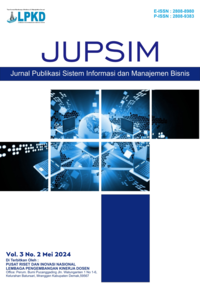Keseimbangan Finansial Bank: Manajemen Modal Kerja, Inflasi, dan Suku Bunga
DOI:
https://doi.org/10.55606/jupsim.v4i2.5337Keywords:
Banking, CAMEL, Inflation, Interest Rate, Panel DataAbstract
This study aims to examine the effects of working capital management, inflation, and interest rates on the financial health of banks in Indonesia during the 2019–2023 period. Employing an associative quantitative approach, the research utilizes panel data from 20 conventional banks listed on the Indonesia Stock Exchange (IDX). The analysis applies the Fixed Effect Model (FEM) as the most appropriate estimator, as determined by the Chow and Hausman tests. The regression results indicate that the Current Ratio exerts a significantly positive influence on CAMEL scores, demonstrating the crucial role of liquidity in strengthening financial health. In contrast, inflation and interest rates have significant negative impacts, suggesting that macroeconomic volatility undermines banking performance. Additional control variables such as firm size, leverage measured by Debt-to-Equity Ratio (DER), and operational efficiency proxied by BOPO also exhibit significant relationships with financial health. The coefficient of determination (R²) of 68.2% implies that the independent variables collectively explain the majority of the variation in the banks’ financial conditions, while the remaining 31.8% is influenced by other external and internal factors not included in the model. These findings highlight the importance of effective liquidity management, prudent leverage, and operational efficiency in maintaining the stability and resilience of the banking sector. Moreover, the results emphasize the need for banks to adopt adaptive strategies to mitigate risks associated with inflationary pressures and interest rate fluctuations. This study provides useful insights for regulators, policymakers, and banking practitioners in formulating strategies to enhance financial stability and ensure sustainable growth in Indonesia’s banking industry.
References
Abor, J. (2005). The effect of capital structure on profitability: An empirical analysis of listed firms in Ghana. Journal of Risk Finance, 6(5), 438–445. https://doi.org/10.1108/15265940510633505
Alipour, M., Mohammadi, M. F., & Derakhshan, H. (2015). Effect of working capital management on corporate profitability: Evidence from Iran. Journal of Accounting and Finance, 15(1), 20–31.
Almazari, A. A. (2014). Impact of internal factors on bank profitability: Comparative study between Saudi and Jordanian banks. Asian Journal of Finance & Accounting, 6(1), 222–239. https://doi.org/10.5296/ajfa.v6i1.4761
Amalia, F., & Widodo, A. (2021). Pengaruh DER dan BOPO terhadap CAMEL pada Bank Umum di Indonesia. Jurnal Ilmu Ekonomi dan Manajemen, 17(2), 145–154.
Barro, R. J. (1995). Inflation and economic growth. National Bureau of Economic Research. https://doi.org/10.3386/w5326
Beck, T., Demirgüç-Kunt, A., & Levine, R. (2004). Bank concentration and fragility: Impact and mechanics. National Bureau of Economic Research Working Paper, No. 10417. https://doi.org/10.3386/w10417
Boyd, J. H., Levine, R., & Smith, B. D. (2001). The impact of inflation on financial sector performance. Journal of Monetary Economics, 47(2), 221–248. https://doi.org/10.1016/S0304-3932(01)00049-6
Deloof, M. (2003). Does working capital management affect profitability of Belgian firms? Journal of Business Finance & Accounting, 30(3‐4), 573–588. https://doi.org/10.1111/1468-5957.00008
Dewi, A. N., & Lestari, S. D. (2022). Pengaruh inflasi terhadap efisiensi operasional dan kinerja keuangan bank. Jurnal Akuntansi Multiparadigma, 13(3), 655–669.
Fama, E. F. (1981). Stock returns, real activity, inflation, and money. The American Economic Review, 71(4), 545–565.
Gitman, L. J. (2015). Principles of Managerial Finance (14th ed.). Pearson Education.
Halim, A., & Fauzi, H. (2019). Pengaruh ukuran perusahaan dan manajemen risiko terhadap kinerja bank. Jurnal Keuangan dan Perbankan, 23(2), 230–244.
Handayani, R., Yusuf, M., & Sari, R. N. (2020). Pengaruh manajemen modal kerja terhadap kinerja keuangan perusahaan manufaktur. Jurnal Ilmu dan Riset Akuntansi, 9(4), 1–16.
Kashyap, A. K., & Stein, J. C. (2000). What do a million observations on banks say about the transmission of monetary policy? American Economic Review, 90(3), 407–428. https://doi.org/10.1257/aer.90.3.407
Kiani, K. M., & Rehman, H. U. (2012). Impact of interest rate changes on the profitability of four major commercial banks in Pakistan. International Journal of Accounting and Financial Reporting, 2(1), 197–216. https://doi.org/10.5296/ijafr.v2i1.1410
Marbun, D., & Sutrisno, E. (2023). Ukuran perusahaan, profitabilitas, dan efisiensi terhadap CAMEL. Jurnal Ekonomi dan Perbankan Indonesia, 18(1), 12–23.
Modigliani, F., & Miller, M. H. (1958). The cost of capital, corporation finance and the theory of investment. The American Economic Review, 48(3), 261–297.
Moussa, M. A. B. (2021). The impact of working capital management on firm profitability: Evidence from North African banks. International Journal of Economics and Financial Issues, 11(1), 35–42.
Nasution, A., & Wiranata, R. (2020). Dampak inflasi dan BI rate terhadap kesehatan keuangan perbankan Indonesia. Jurnal Ekonomi dan Kebijakan Publik, 11(2), 101–112.
Putri, R. Y., & Simbolon, H. (2023). Current ratio dan kinerja keuangan bank di Indonesia. Jurnal Ekonomi dan Bisnis, 17(1), 77–88.
Rahman, M. M., Uddin, M., & Chowdhury, M. A. F. (2021). Interest rate sensitivity and financial soundness of banks in emerging economies. Asian Economic and Financial Review, 11(2), 123–134.
Rahmawati, F., & Sari, I. K. (2019). Pengaruh inflasi, suku bunga, dan kurs terhadap profitabilitas perusahaan sektor konsumsi di BEI. Jurnal Manajemen dan Bisnis Indonesia, 5(1), 15–22.
Sari, A., & Handayani, D. (2021). BOPO sebagai indikator efisiensi dan dampaknya terhadap kinerja CAMEL bank. Jurnal Riset Akuntansi dan Keuangan, 9(1), 88–97.
Sari, N. A., & Nugroho, R. A. (2021). Dampak inflasi dan suku bunga terhadap kinerja keuangan perusahaan selama pandemi. Jurnal Riset Ekonomi dan Bisnis, 14(2), 145–160.
Simanjuntak, R., & Putra, R. (2023). Efisiensi operasional dan kinerja CAMEL bank umum di Indonesia. Jurnal Ilmu Ekonomi dan Perbankan, 15(1), 35–44.
Singh, J. P., & Pandey, S. (2008). Impact of working capital management in the profitability of Hindalco Industries Limited. The IUP Journal of Financial Economics, 6(4), 62–72
Siregar, H., & Harun, M. (2022). Pengaruh suku bunga terhadap NIM dan BOPO pada bank konvensional. Jurnal Ilmu Ekonomi Terapan, 12(2), 104–112.
Yusra, A., Dewi, N. P., & Sugiarto, R. (2023). Analisis pengaruh DER terhadap kinerja CAMEL bank umum. Jurnal Keuangan dan Perbankan Syariah, 9(1), 56–67
Downloads
Published
How to Cite
Issue
Section
License
Copyright (c) 2025 Jurnal Publikasi Sistem Informasi dan Manajemen Bisnis

This work is licensed under a Creative Commons Attribution-ShareAlike 4.0 International License.







